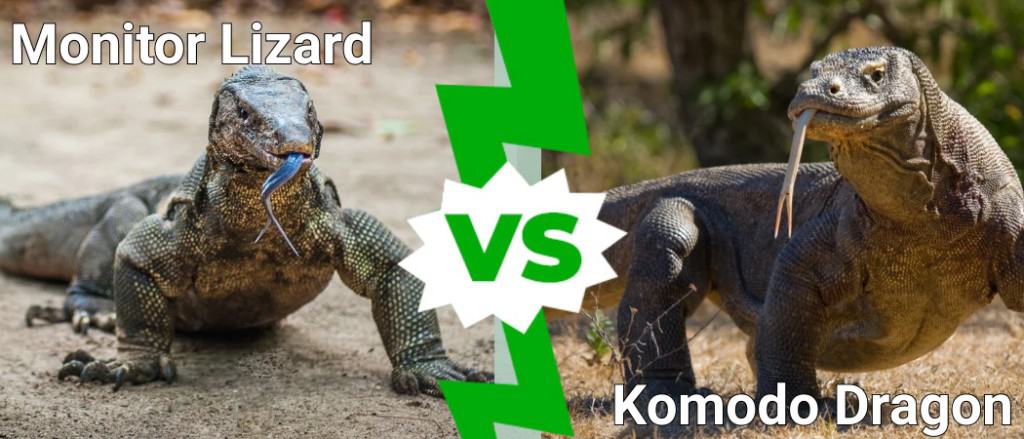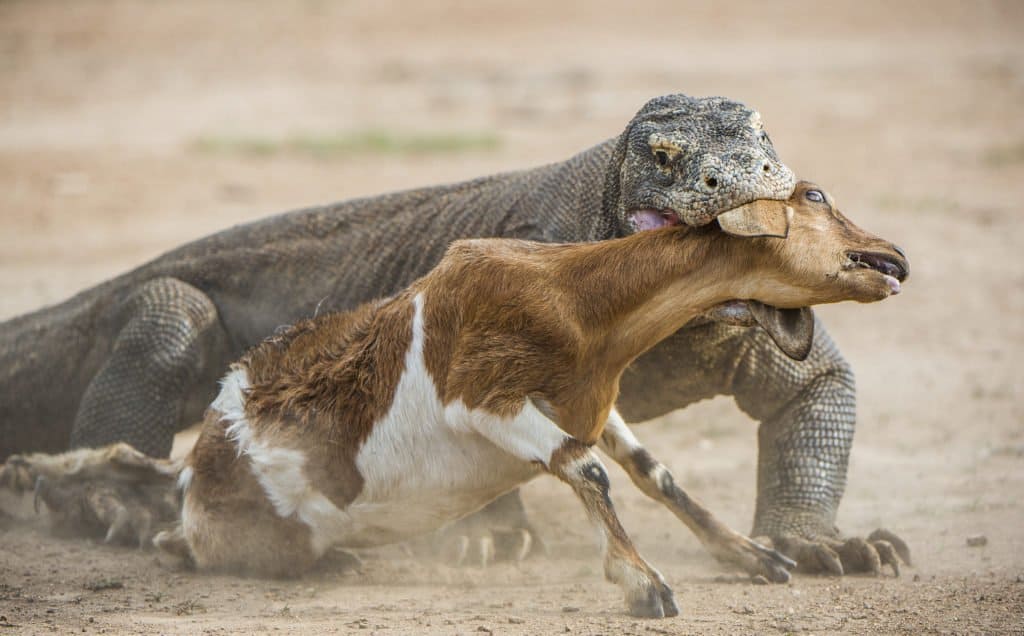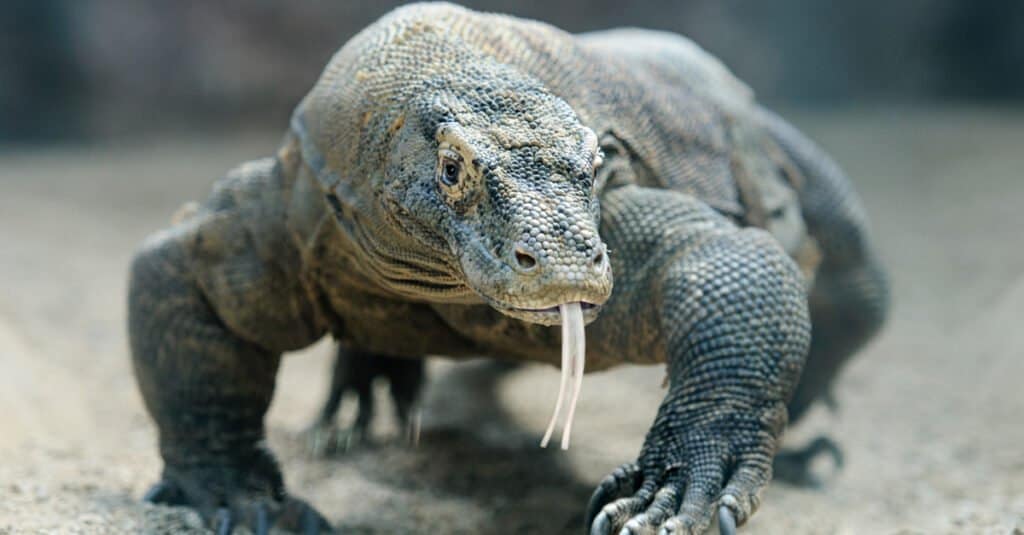Monitor lizards and Komodo dragons are very similar creatures. In fact, Komodo dragons are a type of monitor lizard- but there are many different species of monitor lizards other than the Komodo dragon. To clear up any confusion, Komodo dragons are called Varanus komodoensis. Monitor lizards are from the Varanus family exclusively. However, there are more differences between these lizards.
If you are here to learn about monitor lizards vs. komodo dragons, you’re in the right place. In this article, we’ll discuss the differences between a komodo dragon and a standard monitor lizard in detail so that you can learn how to identify them. Let’s dive in and compare these monster lizards now.
Comparing Monitor Lizard vs. Komodo Dragon

| Monitor Lizard | Komodo Dragon |
|---|---|
| Size 8 inches to 6 feet | 7-10 feet long |
| Appearance Tan, green, or gray in appearance, forked tongues, short legs, long necks, and legs | Bowed legs, flat head, long tail, and claws; rough skin ranging from black to tan |
| Diet Insects, snakes, birds, and small mammals | Deer, goats, pigs, and other lizards (including komodos) |
| Lifespan 8-25 years | 20-30 years |
| Habitat Jungles, aquatic areas, deserts | Indonesia; tropical forests and islands |
| Behavior Shy of humans, docile and alert | Active in the day; avoid humans but can be aggressive. |
The Main Differences Between Monitor Lizard vs Komodo Dragon

A Komodo dragon hunts its prey.
©Sergey Uryadnikov/Shutterstock.com
There are many key differences between the average monitor lizard vs. Komodo dragons. Komodo dragons live longer than the average monitor lizard. Additionally, Komodo dragons are only found in a specific area of Indonesia; other types of monitor lizards are found around the world. While Komodo dragons are a type of monitor lizard, not all monitor lizards are considered Komodo dragons. There are many smaller breeds of monitor lizards, while Komodo dragons are the largest species of monitor lizard.
But this is just where the differences begin. Let’s dive in and learn even more about these lizards now.
Monitor Lizard vs. Komodo Dragon: Appearance
The first difference between a monitor lizard and a Komodo dragon lies in their appearances. Komodo dragons are inherently larger than all other species of monitor lizard, as Komodo dragons are the largest possible species of monitor lizard overall. Given this size difference, the average Komodo dragon can reach up to 300 pounds and over ten feet long, while most monitor lizard species average 3-7 feet long.
Komodo dragons also have a more fearsome appearance than the average monitor lizard, given their large size. The Komodo dragon’s neck and tail are extremely powerful and thick, while some monitor lizard species will have an average-sized tail and neck.

Given this size difference, the average Komodo dragon can reach up to 300 pounds and over ten feet long, while most monitor lizard species average 3-7 feet long.
©Anna Kucherova/Shutterstock.com
Monitor Lizard vs Komodo Dragon: Habitat
Another key difference between monitor lizards and Komodo dragons lies in their habitat preferences. Komodo dragons are only found in Komodo, Indonesia, while many other species of monitor lizard are found around the world. Wild Komodo dragons are only found in Komodo or four surrounding islands nearby. Wild monitor lizards are everywhere.
This leads to another difference in their habitat preferences as well. Komodo dragons enjoy semi-tropical islands and warm weather, while some monitor lizards are more aquatic and can handle cooler temperatures than the average Komodo dragon.

Komodo dragons are only found in Komodo, Indonesia, while many other species of monitor lizard are found around the world.
©Vladislav T. Jirousek/Shutterstock.com
Monitor Lizard vs Komodo Dragon: Diet
Monitor lizards vs. Komodo dragons can have a very different diet. Given the size of the average Komodo dragon, their preferred prey is much larger than the average monitor lizard’s daily meal. Even though both lizard types are carnivorous, Komodo dragons take down deer and goats, while smaller monitor lizard species prefer to eat birds and snakes.
Komodo dragons have even been known to eat one another. Many species of monitor lizards would never consider doing this. However, all monitor lizards, including Komodos, prefer meat over plant material. Insects are another common food source for smaller monitor lizards, though Komodo dragons need much larger prey in order to survive.
Monitor Lizard vs. Komodo Dragon: Lifespan
Another difference between monitor lizards and Komodo dragons lies in their overall lifespan. Komodo dragons can live an average of 20-30 years, if not longer, while the average monitor lizard lives anywhere from 8-20 years, depending on the species.
Lizards living in the wild tend to live less time than lizards in captivity. However, even wild Komodo dragons and monitor lizards live long and healthy lives. Komodo dragons live longer lives than any other species of monitor lizard. This is a common occurrence in just about any type of animal: the bigger you are, the longer you live.

Even though both lizard types are considered carnivorous, komodo dragons tend to take down deer and goats, while smaller monitor lizard species prefer to eat birds and snakes.
©Sergey Uryadnikov/Shutterstock.com
Monitor Lizard vs Komodo Dragon: Behavior
A final key difference between monitor lizards and Komodo dragons lies in their behavior. There are many monitor lizards that are capable of being kept as pets in an average household. This is not the case with Komodo dragons. Komodo dragons are endangered and wild lizards that are meant to stay in the wild, while some species of monitor lizards make ideal pets.
Komodo dragons are one of the most dangerous reptiles on the planet. This isn’t true of all monitor lizard species. However, this is why Komodo dragons are best left alone if you happen to stumble upon one while in Indonesia. These carnivorous lizards are highly adept hunters, and they can even exhibit aggressive behavior toward humans. Monitor lizards are more likely to leave human beings alone!
Can You Survive a Komodo Dragon Bite?

Researchers have discovered that the Komodo dragon has a venom gland in its lower jaw.
©USO/ via Getty Images
A Komodo dragon’s attack can prove deadly, even to humans. Komodo dragons carry a potent venom delivered through their razor-sharp teeth, which has the potential to fatally harm humans within a matter of hours.
In contrast to crocodilians and other reptiles, Komodo dragons possess a relatively less powerful biting force as well as venom in their saliva. Instead, they depend on their sharp, curved teeth and long, robust claws to deliver devastating slashes and tears when attacking their prey.
The Komodo dragon’s teeth are sharp and jagged, which can trap pieces of spoiled food in its mouth. This can turn their saliva into a place where harmful bacteria grow, making untreated bites likely to get infected.
Researchers have also found a venom gland in the dragon’s lower jaw.
Are Monitor Lizards Venomous or Dangerous?
Do humans have to worry about getting bitten by monitor lizards? Though some lizards do have venom glands, the venom produced by monitor lizards is generally harmless to humans and only used to take down small prey. Symptoms of being exposed to venom include swelling, low blood pressure, and interrupted blood flow.
Monitor lizards are typically timid, and they would prefer to keep their distance from people. If you don’t disturb them, they won’t bother you; however, if provoked, they may act aggressively like any other wild animal.
Are Komodo Dragons Venomous or Dangerous?
Komodo Dragons are fascinating creatures that have captured the imagination of many. But one question that is commonly asked is whether they are venomous or dangerous to humans.
The answer to this depends on the individual Komodo Dragon and its behavior. In general, Komodo Dragons do not typically pose a direct threat to humans as their natural prey consists of smaller animals such as rodents, pigs, and rabbits. However, if provoked or threatened by a human being, it could become aggressive and attack with its sharp claws and strong jaws, causing serious injury.
Additionally, these reptiles possess two glands in their lower jaw that secrete several toxins, including anticoagulants which can cause blood loss in an animal that has been bitten by them. So, they can still be quite dangerous if encountered in the wild!
The photo featured at the top of this post is © Anna Kucherova/Shutterstock.com
Thank you for reading! Have some feedback for us? Contact the AZ Animals editorial team.






